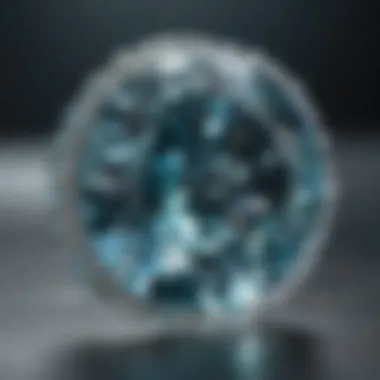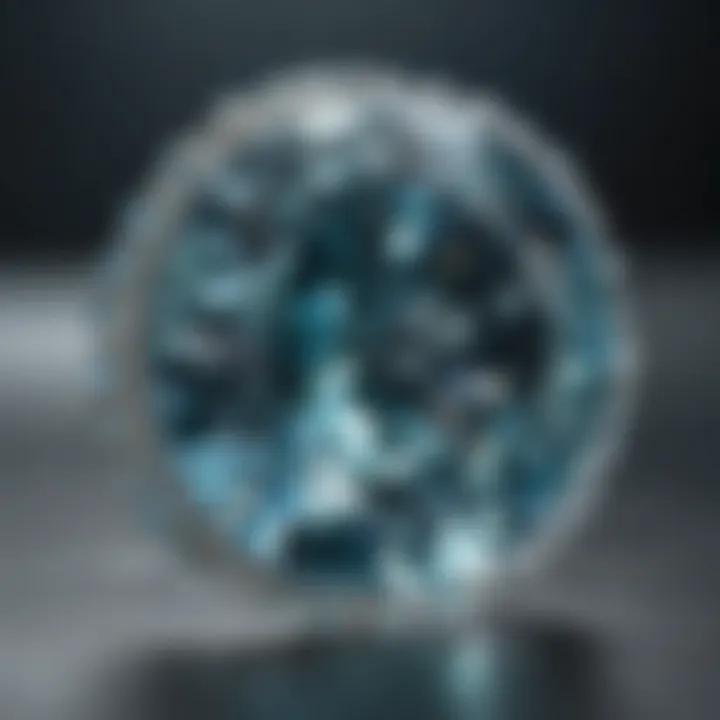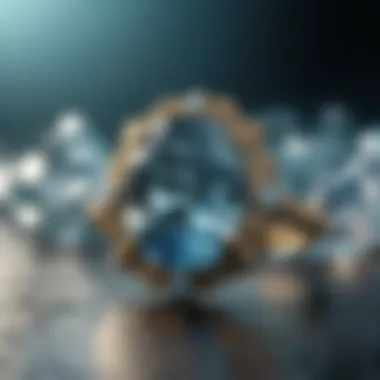Discovering the Meaning and Value of March's Birthstone


Intro
March's birthstone, aquamarine, is not just a precious gem; it is steeped in tradition, history, and cultural significance. This beautiful stone evokes images of tranquil blue seas, embodying the serenity and calm often associated with the month it represents. For those born in March, aquamarine brings more than just aesthetic appeal; it symbolizes clarity, courage, and peace. As we delve into the origins, classifications, and historical significance of aquamarine, a clearer picture of its importance will emerge, unveiling why it holds a special place in the hearts of many.
Gemstone Overview
Definition of Gemstones
Gemstones are naturally occurring minerals, rocks, or organic materials that are valued for their beauty, rarity, and durability. Generally, these gems can be cut and polished into exquisite pieces of jewelry, but their allure extends beyond mere aesthetics. They carry cultural meanings, historical narratives, and are often thought to possess metaphysical properties.
Classification of Gemstones
The classification of gemstones can be quite intricate, primarily categorized into two groups: precious and semi-precious stones. Nevertheless, the lines between these categories often blur, as aesthetic qualities and rarity can greatly influence value. Below are some common classifications:
- Precious gemstones: Typically, this group includes diamonds, rubies, sapphires, and emeralds. Their high value relates to their rarity, durability, and captivating beauty.
- Semi-precious gemstones: While these can still be very beautiful, they are generally more abundant and hence more accessible. Aquamarine, for instance, falls into this category as it is both exquisite and more widely available compared to its precious counterparts.
In addition to these classifications, gemstones can be further divided based on their compositions, colors, or even the specific geological conditions of their formation. Such distinctions enhance the understanding of gemstones like aquamarine, laying groundwork for further exploration.
Historical Significance
Origins of Gemstone Use
The use of gemstones dates back thousands of years, with ancient civilizations incorporating these captivating stones into their rituals, adornments, and even medical practices. To them, gemstones were not just pretty objects, but bearers of power and messages. Aquamarine has particularly interesting ties to maritime lore. Ancient sailors often kept aquamarine on board their vessels, believing it to provide protection and ensure safe passage through turbulent waters.
Cultural Insights: Gemstones in Ancient Civilizations
In various ancient cultures, gemstones had significant roles. Egyptians revered blue stones like aquamarine for their association with the divine. Meanwhile, Romans believed that aquamarine had the ability to calm the waves and protect those who ventured into the sea. This deep-seated legacy speaks volumes about the esteem in which aquamarine was held.
"Aquamarine is said to represent the sea, embodying the timeless beauty and mystery of the ocean depths, reflecting a balance between nature and humanity."
Through the lens of history, one can surmise that aquamarine has not solely been a material possession, but rather a significant token of human culture, history, and identity.
Foreword to March Birthstone
The month of March twinkles with the glint of one of the most appreciated gemstones: aquamarine. The introduction of the March birthstone lays a foundation for unraveling its beauty and significance. Birthstones, historically, have been more than mere decorative pieces; they act as a reflection of identity and personal connections. This section serves to usher readers into the rich narrative surrounding aquamarine, highlighting not just its physical attributes, but its cultural footprints across time.
General Overview of Birthstones
Birthstones have long been celebrated, with roots stretching back to antiquity. Originally drawn from the twelve stones in the Breastplate of Aaron detailed in the Book of Exodus, each gem was believed to hold mystical powers pertinent to the wearer. Today, the tradition maintains its relevance, connecting individuals to their birth month by imbuing gemstones with meaning.
In the modern context, the significance of these gems isn't just about superstition. Birthstones are often considered tokens of luck, protection, and personal growth. They can symbolize various traits, such as courage for aquamarine, inspiring wearers to channel their inner strength.
Birthstones also serve practical purposes for gifting, making them a popular choice for those looking to bestow a meaningful present. Having a better understanding of the birthstone associated with a particular month can add a layer of intent to these gifts, enriching the emotional connection between giver and receiver.
Significance of Birthstones in Different Cultures
Across the globe, the significance of birthstones varies, weaving through different cultural narratives. For instance:
- In Ancient Egypt, it was believed that gemstones held protective qualities. They utilized various stones, including turquoise and aquamarine, for amulets to safeguard against evil and promote health.
- In Indian tradition, the association between birthstones and astrology is strong, as each gem is linked to celestial bodies, believed to influence one's fate and fortune.
- The Jewish culture, pointing back to the Bible, views birthstones as conduits for divine energy and expand upon their symbolic meanings in religious ceremonies.
Notably, many cultures consider the month of one's birth to contain specific energies and strengths that may be harnessed, and stones like aquamarine serve as both a reflection and an enhancer of these attributes. The story of aquamarine, and indeed all birthstones, is rich with layers of meaning that transcend time, connecting individuals with the narratives of their ancestors.
"Gemstones are not simply exquisite adornments; they are symbols of heritage, culture, and aspirations woven through history."
Understanding the broad cultural significance of birthstones provides a deeper appreciation for these gems, framing aquamarine not only as a beautiful gemstone but also as a vessel of collective human experiences and aspirations.
The Gem: Aquamarine
The allure of aquamarine as March's birthstone extends far beyond its aesthetic beauty. Understanding aquamarine's unique characteristics, its color variations, and its role in gemology helps illuminate why it holds such a significant place in the hearts of many. This gem, with its clear blues reminiscent of ocean waves, often evokes feelings of tranquility and clarity—qualities many seek in life.
Aquamarine's Characteristics
Aquamarine, a member of the beryl family, is known for its remarkable durability and clarity. This gemstone typically exhibits a hardness of 7.5 to 8 on the Mohs scale, making it suitable for various types of jewelry, whether it be rings, earrings, or necklaces. Its brilliance can be attributed to its excellent light transmission and unique crystal structure, which allows for a stunning sparkle that captures one’s eye.


What sets aquamarine apart is its transparency, often surpassing that of other gemstones. When polished, it reflects light beautifully, making it a prime choice for high-end jewelry. Many people appreciate its lightweight nature, which allows for comfortable wear.
"Aquamarine’s gentle hues symbolize peace and serenity, creating a calming presence against the bustle of daily life."
Color Variations of Aquamarine
The color of aquamarine can range from pale blue to deep blue-green, depending on the presence of iron in its composition. Here are some of the notable color variations:
- Light Aquamarine: This gentle hue is almost transparent and evokes a sense of softness. It is often sought after for delicate pieces and minimalist designs.
- Medium Aquamarine: A balanced tone that captures the essence of ocean water, medium aquamarine is versatile for stylish everyday wear.
- Dark Aquamarine: Richer in hue, dark aquamarine appears almost mystical, offering a striking contrast that stands out in evening wear and formal events.
Color saturation plays a critical role in determining the value of aquamarine, with deeper and more vibrant colors often fetching higher prices in the market.
Aquamarine in the World of Gemology
In gemology, aquamarine occupies a unique space due to its origins and formation process. Formed in pegmatitic granite rocks, it develops under high temperature and pressure conditions, resulting in the large, flawless crystals that gemologists often admire.
When evaluating this gem, gemologists assess aspects such as:
- Clarity: Minimal inclusions contribute to the gem's overall quality. Higher clarity usually correlates with higher value.
- Cut: The way an aquamarine is cut can enhance its brilliance. Popular cuts include oval, emerald, and round.
- Carat Weight: Larger stones are rarer and thus more valuable, but quality is always prioritized over size.
Understanding these gemological principles can empower collectors and jewelry designers to make informed decisions when sourcing aquamarine. With each crystal being a product of nature, it tells a story of its own, providing a personal connection to its beholder.
Historical Context of Aquamarine
The history of aquamarine is as rich and vibrant as its color. This gemstone has not only graced royal crowns but has also been intertwined with cultural traditions across time. By examining the historical context of aquamarine, we can uncover the layers of significance this stone has held, enhancing our understanding of its allure. Ancient civilizations valued it for more than just its beauty; it served practical and spiritual purposes, thus making it a crucial element in their societies.
Aquamarine in Ancient Civilizations
Aquamarine has been revered throughout various ancient cultures. In ancient Rome, soldiers carried this stone as a talisman, believing it would ensure victory and provide protection in battle. Similarly, the Romans linked the stone to the sea, imagining it as a gift from Poseidon, the god of water. Its blue hues reflected the ocean’s depths, evoking feelings of calm and serenity.
Furthermore, in Ancient Egypt, aquamarine was often considered the stone of the afterlife. During burial rites, it was frequently placed in the tombs of pharaohs, symbolizing a safe passage to the next world. Royalty believed the stone had magical properties and could guide them through the afterlife’s challenges.
"Aquamarine whispers tales of sailors and sea voyages, reminding us of its navigational significance across cultures."
Mythology and Folklore Surrounding Aquamarine
The mythology surrounding aquamarine is equally fascinating. Many legends speak of aquamarine as a mermaid's gemstone, believed to possess the enchantment of the sea. Ancient sailors, spotting the stone's vibrant hues, claimed it provided them protection from the dangers of the ocean. Its name, derived from the Latin for "water of the sea," echoes this connection deeply.
In modern folklore, aquamarine is associated with tranquility and peace. Many believe it can soothe emotional trauma and enhance communication, making it a favored stone among those seeking clarity in relationships. Furthermore, various cultural practices suggest wearing aquamarine can bring good luck and protect against negative energies.
These tales contribute significantly to aquamarine's modern-day appeal. Understanding its historical context enhances our appreciation, revealing not just a beautiful gemstone, but a narrative interwoven with human experiences, dreams, and ambitions.
In exploring the historical significance of aquamarine, we can see how its legacy is a testament to the timeless allure that continues to capture hearts today.
Symbolism and Meaning
The march-born gem, aquamarine, harbors a rich tapestry of meaning and symbolism that transcends mere aesthetics. Understanding these aspects can deepen the appreciation for the stone, connecting it to personal identities and individual experiences. It serves various roles, from a protective talisman to a source of emotional clarity. In this section, we will unravel the layers of significance that aquamarine holds for those fortunate enough to celebrate March birthdays.
Symbolic Representation of Aquamarine
Aquamarine is often linked to the calming elements of water and sky. Its name derives from the Latin aqua marina, meaning "water of the sea," which highlights its intrinsic connection to nature. Visually, aquamarine embodies tranquility with its tranquil blue-green hues, reminiscent of serene ocean waves. In many cultures, the stone symbolizes peace and serenity.
- Calmness: Aquamarine is believed to soothe the spirit and alleviate fears, allowing individuals to communicate with greater clarity.
- Strength: It is also viewed as a crystal of courage, often used by sailors as a protective charm during their voyages, symbolizing the strength to navigate life's turbulent waters.
- Trust: As a stone connected to the throat chakra, aquamarine amplifies trust and honest communication, making it particularly important for those in professions that require clarity of thought and speech.
The gem’s ability to promote relaxation makes it a popular choice in meditation practices, enhancing one’s connection to their inner self. People often associate wearing aquamarine with improved emotional well-being and a greater sense of peace in their lives.
Personal Attributes Associated with March Birthstone
Individuals born in March often relate closely to the traits linked with aquamarine. Its characteristics resonate with a range of personal attributes that can shape their identities. Here are some noteworthy personal attributes associated with those who celebrate their birthdays in March:
- Adaptability: March individuals tend to be adaptable, mirroring the fluid nature of aquamarine. They often handle changes with grace and poise.
- Compassionate Nature: The calming effects of aquamarine can inspire empathy and compassion in March-born people, enabling them to connect deeply with others.
- Intuition: Aquamarine’s connection to the mind may enhance intuition, leading individuals into insightful thinking and decision-making.
In summary, aquamarine is not just a beautiful gemstone; it embodies the essence of its wearers, reflecting their personalities and guiding them through life's challenges.
"Aquamarine connects the bearer to unseen waves of potential, urging them to embrace both their strengths and vulnerabilities."


As we delve deeper into the realm of aquamarine, one gains a profound respect for how this stone intertwines with human experience, adding layers of meaning that extend far beyond its visual allure.
Purchasing and Caring for Aquamarine
Understanding how to buy and maintain aquamarine is critical, especially for those who see its value beyond mere aesthetics. The process of purchasing this beautiful gemstone involves several considerations, not just about its physical appearance but also about quality, authenticity, and the emotional resonance it carries. After all, aquamarine is not just a pretty stone; it symbolizes peace and tranquility, making it a thoughtful gift or personal treasure.
Tips for Buying Aquamarine
When it comes time to find that perfect aquamarine, a good bit of know-how can go a long way. Here are some essential tips:
- Know the Color: Aquamarine shines brightest when it has a striking blue hue. Look for stones that have a rich, vibrant tone without having too much green or gray in them.
- Clarity Matters: The clearer the stone, the more desirable it may be. Many quality aquamarines are inclusions free, but some natural stones can contain minor inclusions that don't detract from their beauty.
- Cut Quality: Look for well-cut aquamarines. A properly executed cut enhances the stone's natural brilliance and makes it more captivating under light.
- Size and Weight: Remember that aquamarine is often valued as much for size as for quality. Larger stones can carry a hefty price tag, so be clear on your budget and weight preference.
- Source Verification: Always inquire about the origin of the gemstone. Authentic sellers should have certification from recognized gemological institutes that testify to the stone's authenticity and quality.
"Authenticity is key. Never feel shy about asking for proof—this is an investment, after all!"
Visiting reputable jewelers or certified gemstone dealers is the best way to avoid pitfalls in the buying process. If purchasing online, ensure that the retailer is reputable, with good customer reviews and return policies in place.
Caring for Aquamarine Jewelry
Once you've made an aquamarine purchase, taking care of your gemstone becomes paramount. Here are some practical tips for keeping aquamarine looking fresh:
- Regular Cleaning: Gently clean your aquamarine jewelry with warm, soapy water and a soft cloth. Avoid harsh chemicals that can dull the stone’s luster. Just a little mild soap should do the trick.
- Storage Strategies: Store your aquamarine separately from other gems to prevent scratches. A soft pouch or a jewelry box with compartments helps keep it safe.
- Avoid Heat: Aquamarine can be sensitive to extreme heat. So, when engaging in activities such as cooking or bathing, it’s wise to remove your jewelry to prevent any potential damage.
- Inspection: Regularly check your aquamarine settings to ensure that the stone is secure. If you notice any looseness, have it checked by a jeweler to avoid a costly loss.
Aquamarine is a jewel deserving of thoughtful care. Just as it embodies steadiness and clarity, so too should the steps we take to ensure it remains a breathtaking addition to our lives. With the right measures in place, your aquamarine will not only shine brightly but also hold its story for years to come.
Aquamarine in Jewelry Design
The significance of aquamarine in jewelry design cannot be overstated. This captivating gemstone, with its soothing blue hues, plays a pivotal role in enhancing the aesthetic appeal and emotional resonance of various pieces crafted by artisans globally. It is more than just a pretty stone; it's a conversation starter, a symbol of tranquility and wisdom. While its beauty is undeniable, understanding its integration into jewelry involves exploring popular settings, contemporary trends, and the thought processes that guide designers in their creations.
Popular Settings and Styles for Aquamarine
Aquamarine shines in an array of settings that can elevate its natural charm. Many jewelers choose to incorporate this gem into classic styles, such as:
- Solitaire Rings: The simplicity of a solitaire setting allows the aquamarine to take center stage, emphasizing its clarity and color.
- Halo Designs: Surrounded by smaller diamonds or white sapphires, a halo setting can amplify the aquamarine’s brilliance and create a striking contrast.
- Three-Stone Rings: Often regarded as a symbol of love, friendship, and fidelity, this arrangement makes a poignant statement, especially for engagements or anniversaries.
- Pendant Necklaces: A single aquamarine stone suspended on a delicate chain can make a bold yet elegant impact, suitable for both casual and formal attire.
- Earrings: Aquamarine can be fashioned into drop or stud earrings, enhancing the wearer’s natural beauty with a splash of color.
Designers frequently blend aquamarine with gold, silver, and platinum, each material imparting a unique flair to the jewelry. The choice of metal can significantly influence the overall vibe of the piece. Cool-toned metals, such as white gold, often create a modern look, while yellow gold can add warmth and richness to the design.
Aquamarine Trends in Contemporary Jewelry
Today’s jewelry fashion takes a more personal approach, allowing individual expression through unique designs. Some notable trends emerging in the aquamarine jewelry scene include:
- Minimalist Styles: Clean lines and understated designs resonate well with those who prefer a less-is-more philosophy. Aquamarine, with its serene hues, fits perfectly into this trend, creating an almost ethereal presence.
- Nature-Inspired Designs: Many designers are drawing inspiration from the natural world to create pieces that embody organic shapes and forms. The fluidity of aquamarine can mimic water, making it a fitting choice for nature-themed jewelry.
- Customization: Custom jewelry design has gained popularity, as consumers seek to create meaningful pieces that narrate their unique stories. Aquamarine is often chosen for bespoke settings that symbolize special occasions, relationships, or milestones.
- Sustainable Practices: As the jewelry industry evolves, there is a growing emphasis on ethical sourcing and sustainable practices. Aquamarine, when sourced responsibly, aligns well with the values of environmentally-conscious consumers.
Aquamarine's role in jewelry design is poised to grow, reflecting cultural shifts and consumer desires. By harmonizing beauty with deeper significance, designers harness the stone's potential to create pieces that tell stories, evoke emotions, and stand the test of time.
"Jewelry is like a biography. A story that tells your experiences, whom you are, and the values you hold dear."
Alternative March Birthstones
When one thinks of the birthstone for March, aquamarine usually comes to mind. However, there are alternative stones linked to this month that deserve a spotlight. Understanding these alternatives can enhance one's appreciation for not just the aquamarine but the broader spectrum of gemstones that coexist beneath the surface. Each stone carries its own history, symbolism, and unique qualities that reflect the diverse characteristics of individuals born in March.
The importance of exploring alternative March birthstones lies in the added depth they bring to the narrative of birthstones. While aquamarine is well-known for its soothing blue tones and serene imagery, alternatives such as bloodstone introduce a contrasting vigor and mystique that can strike a chord with different personalities or tastes. This variety caters to a wider array of preferences, allowing individuals to connect with a stone that resonates more distinctly with their unique identity.
Bloodstone: A Comparison with Aquamarine
Bloodstone, or heliotrope as it is sometimes called, provides a fascinating contrast against the tranquil aquamarine. While aquamarine is celebrated for its calming blue hues reminiscent of the ocean, bloodstone showcases a dramatic deep green base speckled with vibrant reddish-brown spots. This striking appearance is often associated with vitality and strength.
Symbolism: Bloodstone is tied to courage and resilience, making it a powerful stone for those who seek to overcome challenges. Its associations with healing and regeneration are compelling, particularly for individuals who value health and well-being.
Usage in History: Historically, bloodstone has been worn by soldiers as a protective talisman. The connotations of its colors can evoke images of battle and valor, contrasting starkly with the peaceful representations linked to aquamarine.
In terms of valuation, bloodstone may not command the same high prices as aquamarine, which is often preferred for its aesthetic beauty. However, the intrinsic properties of bloodstone offer a richness of meaning that is equally compelling for many.
"Bloodstone reflects the enduring spirit of its wearer, offering strength amidst turmoil and reminding one of the power within."


Other Stones Associated with March: Their Significance
Beyond aquamarine and bloodstone, there are other stones that are sometimes linked to March. Each has its own story and significance:
- Jasper: Known for its grounding qualities, jasper varies in color and has long been associated with stability and protection. It's a go-to stone for those seeking to enhance their daily life with warmth and nurturing.
- Chrysoprase: This bright green chalcedony stone is associated with emotional balance and harmony. It's believed to promote optimism and joy, making it a lively alternative for anyone drawn to vibrant colors.
- Tourmaline: Particularly in shades of blue or green, tourmaline is not only admired for its beauty but also for its protective properties. It is thought to ward off negative energy and promote a sense of well-being.
In summary, these alternative March birthstones enrich the tapestry surrounding March birthdays. They serve as both markers of identity and representation of personal journeys. Whether one feels a stronger connection to the calmness of aquamarine or the vitality of bloodstone, the spectrum of choices available ensures that every March-born individual can find a stone that resonates deeply with them.
Aquamarine in Art and Literature
Aquamarine, with its mesmerizing shades of blue and green, has captivated the minds of artists and writers throughout history. The significance of this gemstone transcends its physical beauty; it becomes a muse for creativity and expression. By exploring these connections, we uncover how aquamarine not only adorns jewelry but also enhances narrative arcs, evokes emotions, and inspires works of art.
References to Aquamarine in Poetry and Literature
When we turn the pages of classic poetry and notable literary works, aquamarine often emerges as a symbol of serenity and clarity. Poets find in this stone a sense of calm that resonates with the waves of the ocean, echoing its very name. For instance, in early 20th-century poetry, one can find references where aquamarine is suggested as a metaphor for the longing of the sea. The depth of the blue, a familiar color in the works of Sylvia Plath, is sometimes likened to aquamarine, symbolizing a profound introspection and emotional transparency.
Furthermore, modern novels often feature aquamarine not only as a precious item but as a significant token tied to character relationships. For instance, a character may carry an aquamarine pendant given by a lost love, representing both cherished memories and the ebb and flow of time. This tangible link between the stone and human experience adds an emotional depth that elevates the narrative, allowing readers to connect intimately with the themes presented.
Visual Art Inspired by Aquamarine
Beyond the realm of words, aquamarine has also inspired countless visual artists. The ethereal qualities of this gemstone have prompted painters and sculptors to integrate its hues into their compositions. Take, for example, the works of Claude Monet, whose delicate brush strokes captured the tranquility of water — he often utilized shades reminiscent of aquamarine to evoke scenes of nature, emphasizing peace and serenity.
Additionally, contemporary artists like Yayoi Kusama have embraced aquamarine in their installations, blending it with her trademark polka dots to create immersive experiences that encourage reflection and mindfulness. These visual narratives allow viewers to engage with the essence of aquamarine deeply, often invoking feelings of calmness and introspection.
Earlier forms of art, like Egyptian jewelry, often incorporated aquamarine and other stones into their creations, highlighting their cultural and spiritual significance. Such pieces were not only ornate but also worn to convey protection and prosperity, adding layers of meaning that resonate through time.
Aquamarine's beauty, both in literature and art, signifies more than just aesthetics; it embodies emotion, memory, and the fluidity of life.
In sum, aquamarine’s journey through art and literature reveals its multifaceted nature. It serves as a bridge connecting the material and emotional worlds, making it a cherished element for those who create and appreciate beauty in all forms.
Metaphysical Properties of Aquamarine
Aquamarine, known for its sea-blue hues, is not just a visual delight; it also carries a range of metaphysical properties that appeal to those who delve into the spiritual realm. Many believe that this stunning gemstone embodies a connection to the sea, evoking feelings of calmness and serenity. As such, it is often regarded as a stone of tranquility, fostering peace in both the mind and body. Those who are enchanted by its beauty also find value in its potential therapeutic benefits. Its gentle energy is thought to harmonize with the emotional body, helping to alleviate fears and anxieties. This characteristic makes aquamarine particularly significant for individuals facing emotional turmoil.
"Aquamarine is like a gentle tide, washing away worries and fears, leaving behind calm waters."
Aquamarine and Emotional Healing
When it comes to emotional healing, aquamarine is reputed to be an outstanding ally. Many believe that this stone can help to dissolve stress and provide clarity during moments of emotional upheaval. Its soothing energies may foster a sense of acceptance, enabling individuals to confront their feelings without judgment. One common practice is to hold aquamarine while engaging in self-reflection or open discussion. This physical connection is thought to enhance communication, whether it's expressing feelings to yourself or in conversations with others.
Some advocates of this stone suggest that keeping aquamarine close can ease emotional burdens and promote a sense of belonging, enhancing interpersonal relationships. Through its gentle blue sheen, it whispers that vulnerability can lead to deeper connections and understanding.
Meditation and Mindfulness with Aquamarine
Aquamarine also garners favor among practitioners of meditation and mindfulness. For those looking to enhance their spiritual practice, this stone can serve as an anchor to the present moment. Its tranquil energy helps individuals drift into a state of calm, free from distractions. Many people find that placing a piece of aquamarine on their meditation space inspires a deeper sense of focus.
Using aquamarine during meditation can aid in achieving clarity of thought. Some techniques involve visualizing the aquamarine while breathing deeply, allowing the mind to settle into a connected awareness. Just as the ocean ebbs and flows, so too can one's energy levels, leading to a balancing of emotions and thoughts.
Incorporating aquamarine into daily practices of mindfulness can also bolster resilience against daily stressors. A simple routine of holding the stone and taking a few deep breaths can serve as a reminder to stay grounded in the fast-paced modern world. Individuals may find themselves more centered, something that is increasingly indispensable in these chaotic times.
By understanding the profound metaphysical properties of aquamarine, one can appreciate not only its aesthetic qualities but also its potential to aid in emotional well-being and mindful living.
Finale
In wrapping up our exploration of the March birthstone, it's essential to reflect on its significance, both as a physical gem and as a symbolic representation of those born in this month. Aquamarine stands out for its soothing hues and rich history, but what truly sets it apart is its deeper meaning for individuals. It’s not just a stone; it’s a tapestry of stories intertwined with personal experiences and cultural narratives.
Summarizing the Essence of March Birthstone
Aquamarine embodies serenity and calmness, attributes that resonate well with the characteristics traditionally assigned to March-born individuals. It symbolizes clarity and harmony, reflecting the tranquil essence of the ocean from which its name is derived. In many cultures, this gemstone is believed to hold protective qualities, especially for sailors who sought its favor during their voyages.
The gemstone's unique blue hues possess a radiance that captivates the eye yet brings a sense of peace to the soul. Each facet tells a story, not just of the earth it comes from but of the emotions it invokes in its wearer. As a birthstone, aquamarine serves as a reminder of the strength and resilience that those born in March carry within themselves. It is a gem that not only adorns but also empowers, carrying both aesthetic and emotional value.
Final Thoughts on Choosing Aquamarine
When it comes to selecting aquamarine, one should consider a few key elements to ensure a choice that resonates personally. First off, pay attention to the gemstone's clarity and hue. A vibrant, pure blue is often seen as the most desirable. However, some might appreciate shades that skew towards greenish-blue, bringing their own unique charm.
Furthermore, think about the setting and style that suits your taste. Whether it's a conventional ring or a more modern necklace, the right design can elevate the significance of the aquamarine. It’s not only a matter of aesthetics; it’s about how the piece complements your personality and lifestyle.
Moreover, always source your aquamarine from reputable dealers, ensuring authenticity and quality. This not only guards against counterfeit stones but also adds to the overall experience of ownership. After all, aquamarine isn't just jewelry; it's a piece of history and a companion for the journey through life.
"Choosing the right gemstone is not just about aesthetics but also about finding a connection that resonates deeply within oneself."



